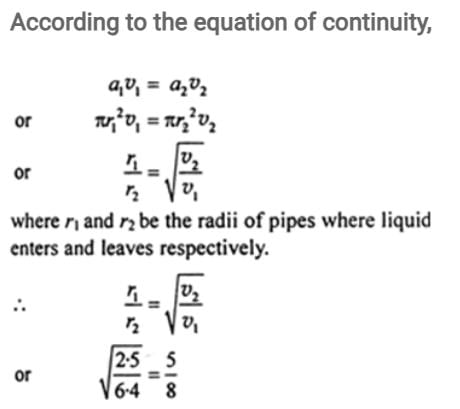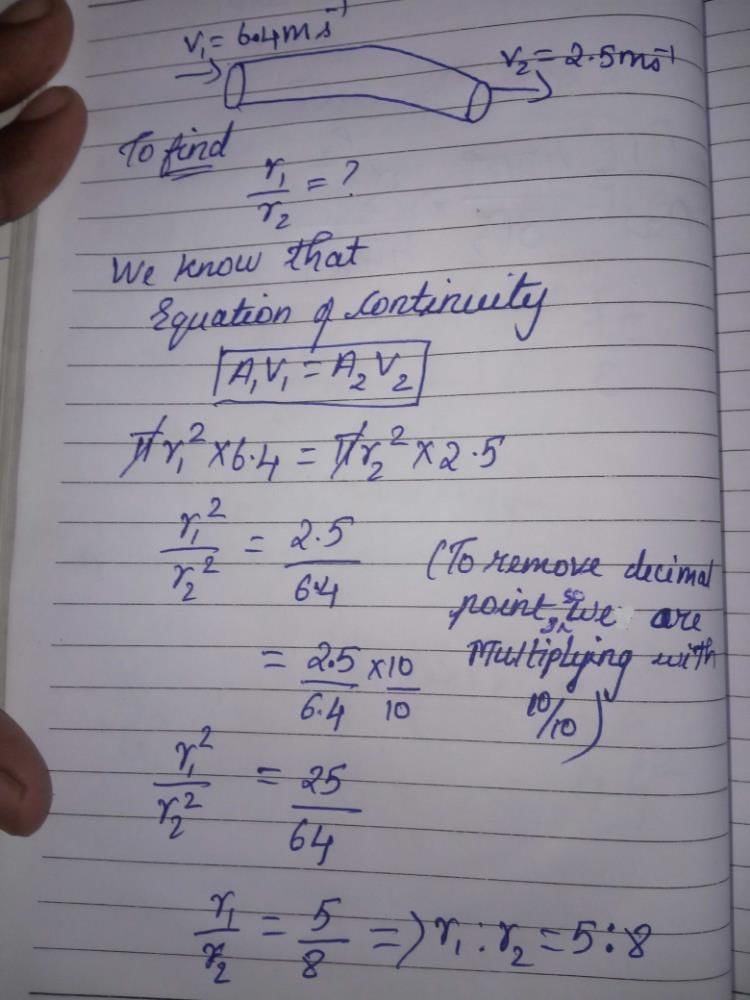Class 11 Exam > Class 11 Questions > A non-viscous liquid flows through a hose. Li...
Start Learning for Free
A non-viscous liquid flows through a hose. Liquid enters with velocity 6.4 m/s and leaves with velocity 2.5 m/s. What is the ratio of radii of the hose where the liquid enters and where it leaves?
- a)5:1
- b)5:8
- c)8:5
- d)8:1
Correct answer is option 'B'. Can you explain this answer?
Verified Answer
A non-viscous liquid flows through a hose. Liquid enters with velocity...

Most Upvoted Answer
A non-viscous liquid flows through a hose. Liquid enters with velocity...

Free Test
FREE
| Start Free Test |
Community Answer
A non-viscous liquid flows through a hose. Liquid enters with velocity...
Given, the velocity of the liquid at the inlet of the hose is 6.4 m/s and at the outlet of the hose is 2.5 m/s. We need to find the ratio of radii of the hose at the inlet and outlet.
Let the radius of the hose at the inlet be r1 and at the outlet be r2.
By the principle of continuity, the volume of liquid flowing per unit time at the inlet must be equal to the volume of liquid flowing per unit time at the outlet.
Therefore, A1v1 = A2v2, where A1 and A2 are the cross-sectional areas of the hose at the inlet and outlet respectively.
Since the liquid is non-viscous, we can assume that the pressure at the inlet and outlet of the hose are the same.
Using Bernoulli's equation, we can write:
1/2ρv1^2 + ρgh1 + P = 1/2ρv2^2 + ρgh2 + P
where ρ is the density of the liquid, h1 and h2 are the heights of the inlet and outlet above some reference level, and P is the pressure at the inlet and outlet.
Since the pressure is the same at the inlet and outlet, we can cancel out the P terms in the equation.
Simplifying the equation, we get:
1/2ρ(v1^2 - v2^2) + ρg(h1 - h2) = 0
Since the liquid is flowing horizontally, h1 = h2. Therefore, the above equation reduces to:
1/2ρ(v1^2 - v2^2) = 0
Solving for v1/v2, we get:
v1/v2 = √(A2/A1)
Substituting the given values of v1, v2 and simplifying, we get:
r1/r2 = √(v2/v1) = √(2.5/6.4) ≈ 5/8
Therefore, the ratio of radii of the hose at the inlet and outlet is 5:8, which is option (b).
Let the radius of the hose at the inlet be r1 and at the outlet be r2.
By the principle of continuity, the volume of liquid flowing per unit time at the inlet must be equal to the volume of liquid flowing per unit time at the outlet.
Therefore, A1v1 = A2v2, where A1 and A2 are the cross-sectional areas of the hose at the inlet and outlet respectively.
Since the liquid is non-viscous, we can assume that the pressure at the inlet and outlet of the hose are the same.
Using Bernoulli's equation, we can write:
1/2ρv1^2 + ρgh1 + P = 1/2ρv2^2 + ρgh2 + P
where ρ is the density of the liquid, h1 and h2 are the heights of the inlet and outlet above some reference level, and P is the pressure at the inlet and outlet.
Since the pressure is the same at the inlet and outlet, we can cancel out the P terms in the equation.
Simplifying the equation, we get:
1/2ρ(v1^2 - v2^2) + ρg(h1 - h2) = 0
Since the liquid is flowing horizontally, h1 = h2. Therefore, the above equation reduces to:
1/2ρ(v1^2 - v2^2) = 0
Solving for v1/v2, we get:
v1/v2 = √(A2/A1)
Substituting the given values of v1, v2 and simplifying, we get:
r1/r2 = √(v2/v1) = √(2.5/6.4) ≈ 5/8
Therefore, the ratio of radii of the hose at the inlet and outlet is 5:8, which is option (b).

|
Explore Courses for Class 11 exam
|

|
Question Description
A non-viscous liquid flows through a hose. Liquid enters with velocity 6.4 m/s and leaves with velocity 2.5 m/s. What is the ratio of radii of the hose where the liquid enters and where it leaves?a)5:1b)5:8c)8:5d)8:1Correct answer is option 'B'. Can you explain this answer? for Class 11 2025 is part of Class 11 preparation. The Question and answers have been prepared according to the Class 11 exam syllabus. Information about A non-viscous liquid flows through a hose. Liquid enters with velocity 6.4 m/s and leaves with velocity 2.5 m/s. What is the ratio of radii of the hose where the liquid enters and where it leaves?a)5:1b)5:8c)8:5d)8:1Correct answer is option 'B'. Can you explain this answer? covers all topics & solutions for Class 11 2025 Exam. Find important definitions, questions, meanings, examples, exercises and tests below for A non-viscous liquid flows through a hose. Liquid enters with velocity 6.4 m/s and leaves with velocity 2.5 m/s. What is the ratio of radii of the hose where the liquid enters and where it leaves?a)5:1b)5:8c)8:5d)8:1Correct answer is option 'B'. Can you explain this answer?.
A non-viscous liquid flows through a hose. Liquid enters with velocity 6.4 m/s and leaves with velocity 2.5 m/s. What is the ratio of radii of the hose where the liquid enters and where it leaves?a)5:1b)5:8c)8:5d)8:1Correct answer is option 'B'. Can you explain this answer? for Class 11 2025 is part of Class 11 preparation. The Question and answers have been prepared according to the Class 11 exam syllabus. Information about A non-viscous liquid flows through a hose. Liquid enters with velocity 6.4 m/s and leaves with velocity 2.5 m/s. What is the ratio of radii of the hose where the liquid enters and where it leaves?a)5:1b)5:8c)8:5d)8:1Correct answer is option 'B'. Can you explain this answer? covers all topics & solutions for Class 11 2025 Exam. Find important definitions, questions, meanings, examples, exercises and tests below for A non-viscous liquid flows through a hose. Liquid enters with velocity 6.4 m/s and leaves with velocity 2.5 m/s. What is the ratio of radii of the hose where the liquid enters and where it leaves?a)5:1b)5:8c)8:5d)8:1Correct answer is option 'B'. Can you explain this answer?.
Solutions for A non-viscous liquid flows through a hose. Liquid enters with velocity 6.4 m/s and leaves with velocity 2.5 m/s. What is the ratio of radii of the hose where the liquid enters and where it leaves?a)5:1b)5:8c)8:5d)8:1Correct answer is option 'B'. Can you explain this answer? in English & in Hindi are available as part of our courses for Class 11.
Download more important topics, notes, lectures and mock test series for Class 11 Exam by signing up for free.
Here you can find the meaning of A non-viscous liquid flows through a hose. Liquid enters with velocity 6.4 m/s and leaves with velocity 2.5 m/s. What is the ratio of radii of the hose where the liquid enters and where it leaves?a)5:1b)5:8c)8:5d)8:1Correct answer is option 'B'. Can you explain this answer? defined & explained in the simplest way possible. Besides giving the explanation of
A non-viscous liquid flows through a hose. Liquid enters with velocity 6.4 m/s and leaves with velocity 2.5 m/s. What is the ratio of radii of the hose where the liquid enters and where it leaves?a)5:1b)5:8c)8:5d)8:1Correct answer is option 'B'. Can you explain this answer?, a detailed solution for A non-viscous liquid flows through a hose. Liquid enters with velocity 6.4 m/s and leaves with velocity 2.5 m/s. What is the ratio of radii of the hose where the liquid enters and where it leaves?a)5:1b)5:8c)8:5d)8:1Correct answer is option 'B'. Can you explain this answer? has been provided alongside types of A non-viscous liquid flows through a hose. Liquid enters with velocity 6.4 m/s and leaves with velocity 2.5 m/s. What is the ratio of radii of the hose where the liquid enters and where it leaves?a)5:1b)5:8c)8:5d)8:1Correct answer is option 'B'. Can you explain this answer? theory, EduRev gives you an
ample number of questions to practice A non-viscous liquid flows through a hose. Liquid enters with velocity 6.4 m/s and leaves with velocity 2.5 m/s. What is the ratio of radii of the hose where the liquid enters and where it leaves?a)5:1b)5:8c)8:5d)8:1Correct answer is option 'B'. Can you explain this answer? tests, examples and also practice Class 11 tests.

|
Explore Courses for Class 11 exam
|

|
Signup for Free!
Signup to see your scores go up within 7 days! Learn & Practice with 1000+ FREE Notes, Videos & Tests.
























